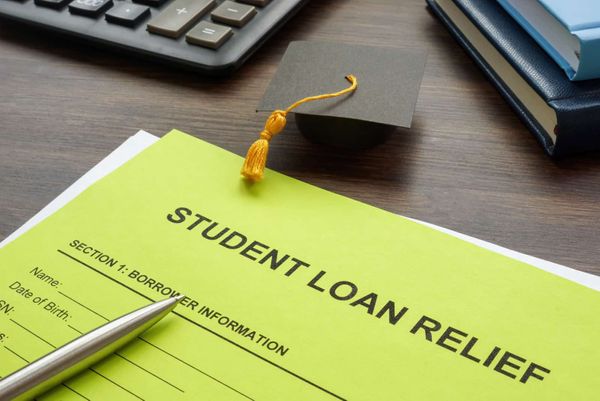Student loan forgiveness programs have made the news recently thanks to petitions calling for President Joe Biden to cancel all student debt. But regardless of how the government responds to increasing demand for these measures, there are already various programs that can help borrowers to clear their loans.
Make no mistake — although the name sounds promising, student loan forgiveness isn’t exactly a quick fix, and not everyone can take advantage of it. But this can still be a lifeline for many, so let’s take a closer look at which options are out there.
Public Service Loan Forgiveness (PSLF)
The best-known and most far-reaching scheme is the Public Service Loan Forgiveness program, which covers individuals working full-time for a wide range of public-sector organizations, including state, federal, and local government agencies and 501(c)(3)-designated nonprofits.
However, not every public-sector worker is eligible, so proceed with caution if you’re applying for a job purely to be part of the PSLF. You also need to be enrolled in a qualifying repayment plan for an eligible loan.
Unlike many other categories of loan forgiveness programs, being accepted onto the PSLF really will wipe your loan clean. Once you’ve made 120 payments, the government will pay off the remainder. Of course, that means you’re committed to the program (and the public sector) for ten years — it’s no easy ride.
Plus, there’s another catch. Being accepted onto the PSLF isn’t easy, and some reports suggest 99% of applications are rejected.
Income-Based Repayment (IBR)
Did you have it drilled into you from a young age that pursuing a higher education would increase your earning potential, only for a harsher reality to hit you when you graduated from college? Whether you chose love over money or the job market turned out to be weaker than you were hoping, the good news is that you don’t always have to be saddled with loan payments disproportionate to your salary.
The Income-Based Repayment plan ensures that borrowers never have to spend more than 10% or 15% of their discretionary income on loan repayments. Then, if they continue to make these payments for 20 or 25 years, the balance will be forgiven (the exact percentage and number of years depends on when you join the plan).
For most people, the prospect of paying 15% of income toward a student loan payment for up to 25 years probably doesn’t sound very appealing, but it can make sense for graduates with low salaries yet high amounts of debt — especially if they don’t expect that to change any time soon.
Pay As You Earn (PAYE)
The idea behind Pay As You Earn is pretty similar to the IBR program — graduates pay a percentage of their loan every month and are eventually granted loan forgiveness.
However, in the PAYE program, the monthly payment is capped at just 10% and the balance is forgiven after 20 years. This makes it a more favorable option for most people.
To qualify, the most important criteria is facing monthly payments from your loan payment plan that are higher than they would be under the PAYE program. Also, you should have a qualifying loan and plan that you took out from October 2007 as a new borrower (or through a direct loan disbursement from October 2011).
Revised Pay As You Earn (REPAYE)
Don’t quite meet the criteria for PAYE or IBR but still desperately want to lower your monthly loan payments? You might be able to join Revised Pay As You Earn instead.
Just like PAYE, REPAYE caps payments at 10% of discretionary income, and the total balance will be forgiven after making 20 years of payments (except loans for graduate programs, which take 25 years to be forgiven).
However, there’s one major difference — anyone can join this program, regardless of how much they earn or whether they’d save money compared to their standard loan payment plan. So, make sure you’re consistently comparing the two, or you could end up overpaying!
Income-Contingent Repayment (ICR)
Sometimes confused with the IBR plan, Income-Contingent Repayment offers borrowers the chance to adjust their monthly payments based on their income level.
It might not seem like the ICR is offering anything new, but it has one key difference compared to other plans: you can use it with parent PLUS loans (as long as you consolidate the loans first), which are generally excluded from student loan forgiveness programs.
Federal Perkins Loan Cancellation
Federal Perkins loans are one of the most common loan types, and fortunately, they also have their own dedicated forgiveness program.
On this plan, you’ll pay whichever is less of the following: the equivalent to what you’d pay on a standard 12-year plan or 20% of your discretionary income. As you make your payments, the program will gradually forgive student loan debt on a yearly basis in small chunks, and this could eventually result in having the entire debt canceled.
However, there’s one major caveat — only those in certain lines of work can qualify, which are mostly public sector professions like teachers, nurses, and those in the military.
Other Options
In addition to the forgiveness programs outlined above, you may also be eligible for student loan forgiveness due to exceptional circumstances, or career-specific forgiveness programs.
So, be sure to search for forgiveness programs for your specific career — especially if you work in a public sector profession, the military, or in STEM.
Special circumstances that make someone eligible for forgiveness (or “student loan discharge”) include:
- Attending a school that has now closed down
- Bankruptcy
- Severe, permanent disability
- Receiving a false certification
Naturally, nobody wants to be in one of the situations outlined above, but it’s reassuring that you won’t have to pay back your loan if you do face any of these scenarios.
Ready to be forgiven and forgotten?
Student debt is stressful and overwhelming to deal with, but don’t fall into the trap of burying your head in the sand to try and avoid it. This could shoot you in the foot if you end up paying more than you should!
With any luck, you’ll be able to pay off your debt quicker than you’d hoped or make your life more tolerable using one of the programs examined here.
But even if you’re not lucky enough to be eligible for any of the plans above, don’t lose hope quite yet — you can still pay off your own debt the old-fashioned way with a bit of frugality or extra earning power. We wish you luck!







